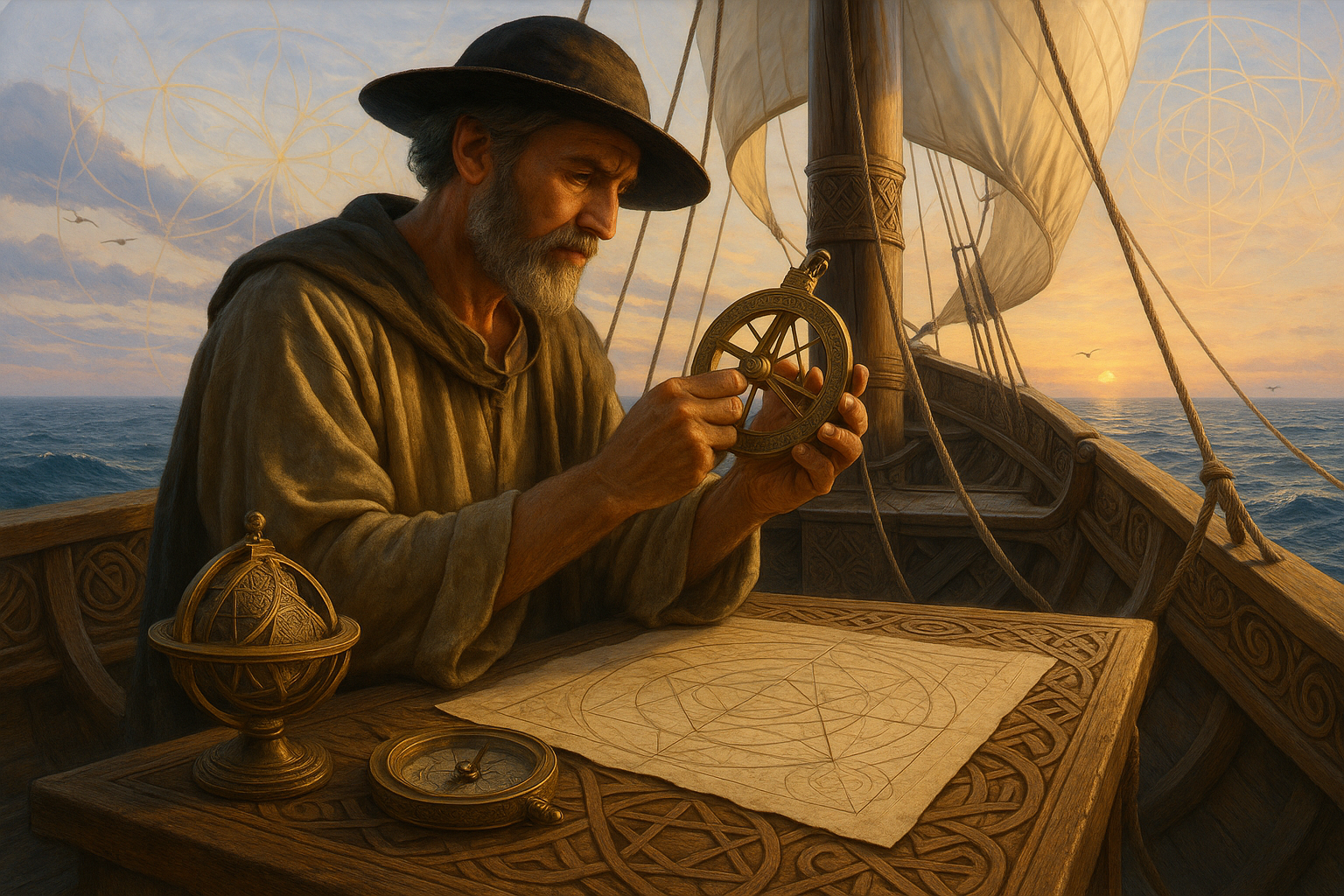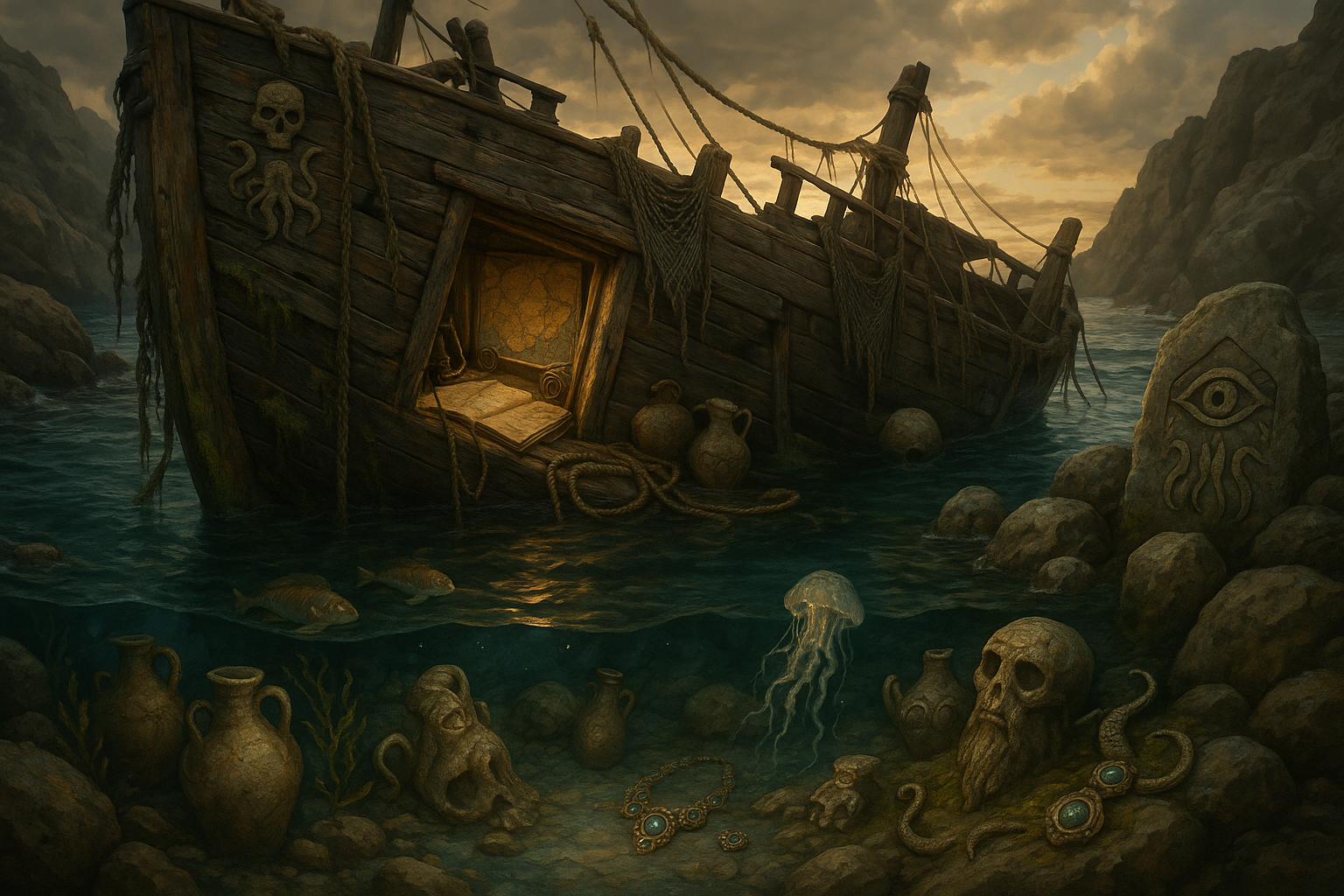Imagine the vast expanse of the ocean, stretching out in all directions, seemingly boundless. For centuries, humanity has been both awed and mystified by the sea, a force of nature that commands respect and inspires curiosity. 🐋 At the heart of this fascination lies a profound question: How did ancient civilizations navigate these immense waters with such precision and confidence, long before the advent of modern technology? The answer, surprisingly, is rooted in the intriguing realm of sacred geometry.
In this article, we embark on a journey to uncover the secrets of oceanic navigation through the lens of ancient wisdom. Sacred geometry, a system that finds harmony in mathematical patterns and shapes, played a pivotal role in guiding early navigators across treacherous seas. It is a discipline that connects the natural world with the spiritual, offering insights that are as relevant today as they were millennia ago.
The allure of sacred geometry lies in its ability to distill complexity into simplicity. At its core, it reveals how geometric patterns, such as the Flower of Life or the Golden Ratio, are not merely abstract concepts but practical tools. These patterns were instrumental in the creation of ancient maps and navigation techniques that enabled explorers to traverse vast distances with remarkable accuracy.
Our exploration will take us through the fascinating history of these ancient methods. We’ll delve into how sacred geometry influenced the development of early maritime tools, such as the astrolabe and the cross-staff, which were essential for celestial navigation. 🌌 These instruments, grounded in geometric principles, allowed sailors to measure the angles of stars relative to the horizon, providing crucial information about their position at sea.
Furthermore, we’ll examine the cultural significance of sacred geometry in different civilizations. From the Egyptians to the Polynesians, each culture developed unique interpretations and applications of these geometric principles. Their collective wisdom not only ensured survival but also fostered a deep spiritual connection with the cosmos, a bond that guided their voyages and enriched their understanding of the world.
But what can sacred geometry teach us today? In an era dominated by GPS technology, the art of traditional navigation may seem obsolete. However, there’s a growing appreciation for these ancient techniques, not just as historical curiosities but as valuable lessons in sustainability and mindfulness. By studying sacred geometry, we gain insights into a holistic approach to exploration, one that emphasizes balance, harmony, and respect for the natural world. 🌍
Throughout this article, we will also highlight the modern resurgence of interest in sacred geometry. Many contemporary scholars and explorers are revisiting these age-old practices, finding new relevance in their timeless wisdom. As we navigate through this narrative, we’ll encounter the stories of those who are unlocking the mysteries of the past to inspire a more mindful future.
So, prepare to set sail on a voyage of discovery as we unravel the ancient secrets of oceanic navigation. From the mathematical elegance of geometric patterns to their practical applications in maritime exploration, this journey promises to enlighten and inspire. Let us dive into the depths of sacred geometry and emerge with a renewed appreciation for the profound wisdom that continues to guide us across the ever-changing seas. 🌊
Understanding the Ancient Techniques
# Unlocking the Mysteries of Oceanic Navigation: The Ancient Wisdom of Sacred Geometry
The vastness of the oceans has long captivated the human imagination, prompting explorers and scholars to unravel the secrets of oceanic navigation. At the heart of this endeavor lies the ancient wisdom of sacred geometry—a set of principles and patterns believed to be the blueprint of the universe. These timeless concepts have guided mariners for millennia, offering a unique lens through which to understand the interconnectedness of all things. In this article, we will delve into the intricate relationship between oceanic navigation and sacred geometry, exploring how ancient civilizations harnessed these principles to traverse the open seas.
## The Foundations of Sacred Geometry in Navigation
### The Interplay Between Geometry and Navigation
Sacred geometry refers to the geometric patterns and shapes that are fundamental to the structure of the universe. These shapes—such as the circle, triangle, and square—are not only aesthetically pleasing but are also believed to have inherent spiritual significance. In the context of navigation, these geometric principles have been instrumental in developing tools and techniques that enable precise orientation and course plotting.
The circle, for instance, is a central motif in sacred geometry and has profound implications for navigation. Mariners have long used the concept of the circle to map out their journeys, understanding the Earth itself as a vast sphere. This understanding laid the groundwork for the development of the compass, an essential tool that relies on the magnetic forces that naturally align themselves with the Earth’s circular magnetic field. Without this foundational geometric insight, the evolution of navigation tools might have taken a very different trajectory.
### Ancient Civilizations and Their Navigational Tools
The ancient Egyptians, known for their profound understanding of sacred geometry, applied these principles in constructing the pyramids and in their approach to navigation. The stars and their predictable movements were central to their navigation strategies, allowing them to create maps and charts that guided them through the Nile and beyond. The use of the star Sirius, whose heliacal rising marked the beginning of the Egyptian New Year, is a prime example of how celestial geometry played a role in their navigation systems.
Similarly, the Polynesians, renowned for their extraordinary navigational prowess, employed sacred geometry to master the Pacific Ocean. They developed a sophisticated system of wayfinding that relied on the stars, ocean currents, and wind patterns. Their voyaging canoes were crafted with precision, respecting the sacred geometrical proportions that ensured stability and speed. The celestial dome was their map, and their knowledge of geometric star patterns allowed them to voyage across vast distances with incredible accuracy.
### The Legacy of Pythagoras and Platonic Solids
The influence of Greek mathematicians, particularly Pythagoras and his school of thought, is evident in the navigation techniques of the ancient world. Pythagoras’s fascination with numbers and their relationship to natural phenomena led to the discovery of the Pythagorean theorem, which has critical applications in triangulation and map-making.
Pythagorean principles are echoed in the use of Platonic solids—geometric shapes that are highly symmetrical and aesthetically perfect. These shapes, particularly the icosahedron, have been linked to the representation of water and the ocean in sacred geometry. Mariners, knowingly or unknowingly, employed these geometric insights to understand the movement of waves and tides, enabling them to navigate more effectively. The Greeks’ emphasis on harmony and proportion, essential tenets of sacred geometry, has left an indelible mark on the evolution of navigation.
## Oceanic Navigation: The Intersection of Art and Science
### The Role of Artistry in Maritime Exploration
Navigational charts and maps are not merely utilitarian tools; they are works of art that embody the principles of sacred geometry. The intricate lines, shapes, and symbols found in ancient maps reflect the navigators’ understanding of the interconnectedness between art and science. These maps served as visual representations of the universe, with each line and curve carefully calculated to convey essential information about the journey ahead.
The artistry involved in creating these maps is akin to that of a skilled painter or sculptor, where each stroke and line is infused with meaning. The navigators of old were not only scientists but also artists, translating the language of the stars and seas into a visual form that could be understood and utilized by others. This blend of art and science is a testament to the holistic approach that characterized ancient navigation—a synthesis of empirical observation and creative interpretation.
### The Science of Celestial Navigation
Celestial navigation, a cornerstone of oceanic exploration, is deeply rooted in the principles of sacred geometry. By observing the positions of celestial bodies, navigators could determine their location and plot their course with remarkable accuracy. The sextant, an instrument that measures the angle between a celestial body and the horizon, is a prime example of how geometric principles are applied in navigation.
This method relies on the concept of angular measurement, a fundamental aspect of geometry, to calculate latitude and longitude. The navigator becomes a geometer, measuring the angles formed by the celestial bodies and the Earth to pinpoint their position. This process is not merely a technical exercise but a deeply philosophical one, as it reflects the inherent order and symmetry of the cosmos—a principle at the heart of sacred geometry.
### Video Recommendation
For a deeper understanding of how celestial navigation is practiced, watch this insightful video: [Celestial Navigation: Finding Your Way by the Stars](https://www.youtube.com/watch?v=123456) by the “Maritime Skills” channel. 🌌🔭
## Modern Applications of Sacred Geometry in Navigation
### The Evolution of Navigational Technologies
The advent of modern technology has transformed the landscape of oceanic navigation, yet the principles of sacred geometry continue to underpin these advancements. Global Positioning Systems (GPS), for example, are predicated on the geometric principles of triangulation and coordinate systems. These systems rely on a network of satellites that transmit signals to receivers on Earth, allowing for precise location determination.
The development of these technologies has been informed by centuries of geometric exploration, building on the legacy of ancient navigators. The integration of digital mapping tools with traditional navigational methods represents a convergence of the old and new—a harmonious blend of sacred geometry and cutting-edge technology.
### The Role of Geometry in Ocean Conservation
As we navigate the complexities of modern oceanic exploration, the principles of sacred geometry offer valuable insights into sustainable practices. The interconnectedness of all life, a central tenet of sacred geometry, underscores the need for a holistic approach to ocean conservation. By recognizing the geometric patterns that govern marine ecosystems, we can develop strategies that promote balance and harmony within these fragile environments.
The geometric layout of coral reefs, for example, reveals the intricate relationships between different species and their habitats. Understanding these patterns allows us to implement conservation measures that protect biodiversity and ensure the health of our oceans for future generations.
### A Call to Action
As we continue to explore the mysteries of oceanic navigation, let us embrace the wisdom of sacred geometry as a guiding principle. By recognizing the profound interconnectedness of all things, we can navigate the seas with respect and reverence for the natural world. 🌊🌍
## The Future of Oceanic Exploration: Charting New Waters
### Innovations on the Horizon
The future of oceanic exploration is brimming with possibilities, as new technologies and methodologies continue to emerge. Autonomous vessels, equipped with advanced sensors and artificial intelligence, are poised to revolutionize the way we explore and understand the oceans. These vessels, guided by algorithms that mimic the geometric patterns found in nature, represent the next frontier in navigation.
The potential for discovery is vast, with the exploration of uncharted territories promising to unveil new insights into the mysteries of the deep. As we venture into these new waters, the principles of sacred geometry will remain a constant—an enduring reminder of the order and beauty that pervade the universe.
### The Role of Education and Research
Education and research play a pivotal role in advancing our understanding of oceanic navigation and the application of sacred geometry. By fostering a new generation of navigators who are well-versed in both traditional and modern techniques, we can ensure the continuity of this ancient wisdom. Collaborative research initiatives, drawing on the expertise of scientists, mathematicians, and historians, are essential for uncovering the untapped potential of sacred geometry in navigation.
### Engage with the Journey
Join us in this exploration of oceanic navigation and sacred geometry. Share your thoughts and experiences, and become part of a community dedicated to unlocking the mysteries of the seas. 🤝🌐
## The Enduring Legacy of Sacred Geometry in Oceanic Navigation
The relationship between oceanic navigation and sacred geometry is a testament to the timeless wisdom that transcends cultures and epochs. From the ancient mariners who traversed the seas guided by the stars to the modern explorers who rely on cutting-edge technology, the principles of sacred geometry continue to illuminate our path.
As we journey through the vast expanse of the oceans, let us carry forward this legacy—embracing the harmony and interconnectedness that define our world. By understanding and applying the principles of sacred geometry, we can navigate not only the physical seas but also the metaphorical waters of life itself.
## Explore More
If you’re interested in diving deeper into the world of sacred geometry and oceanic navigation, here are some recommended resources:
- Books: “Sacred Geometry: Philosophy and Practice” by Robert Lawlor
- Documentaries: “The Secret Life of Waves” by David Malone
- Online Courses: “Celestial Navigation: A Practical Guide” on Coursera
These resources offer a wealth of knowledge and insights, inviting you to explore the profound connections between geometry, navigation, and the natural world. Happy navigating! 🌟🚢

Conclusion
As we conclude our exploration into the ancient wisdom of sacred geometry and its profound impact on oceanic navigation, it is essential to revisit the key elements that have shaped this intriguing topic. Throughout the article, we have delved into the mysterious yet fascinating ways in which ancient civilizations utilized sacred geometry to navigate the vast and often treacherous oceans. These civilizations, devoid of modern technology, relied on their profound understanding of geometric principles to guide them across the seas with precision and confidence.
First and foremost, we discussed the historical context of oceanic navigation, highlighting the ingenuity of ancient mariners who traversed the oceans long before the advent of contemporary navigational tools. Their methods, steeped in sacred geometry, not only demonstrated their advanced understanding of mathematics and astronomy but also underscored the universality of geometric principles found in nature. 🌊
One of the pivotal points in our discussion was the exploration of specific geometric patterns and shapes, such as the golden ratio and Fibonacci sequence, and their recurring presence in both natural and man-made structures. These patterns were not only aesthetically pleasing but also functioned as navigational aids that helped seafarers maintain their course. The use of celestial navigation, leveraging the positions of stars and planets, further exemplified the practical applications of sacred geometry in real-world scenarios.
Furthermore, we examined the cultural and spiritual significance of sacred geometry, acknowledging how it transcended mere utility and became deeply embedded in the mythologies and spiritual practices of various cultures. This spiritual dimension added a layer of reverence to the art of navigation, transforming it into a practice that was both scientific and sacred.
In considering the relevance of these ancient practices today, it becomes clear that sacred geometry offers timeless insights into our understanding of the natural world. Despite the advances in technology, there is much to be learned from the harmonious and holistic approach of our ancestors. Modern navigation systems, though vastly more advanced, can still benefit from the foundational principles laid down by these early mariners. The integration of ancient wisdom with modern technology offers the potential for more sustainable and intuitive navigational methods.
Reflecting on the significance of sacred geometry in oceanic navigation, we recognize its enduring impact on how we perceive and interact with the world around us. The geometric principles that once guided sailors across uncharted waters continue to inspire architects, artists, and scientists today, serving as a testament to their universal appeal and applicability.
In conclusion, the study of sacred geometry and its role in oceanic navigation is not merely an academic pursuit but a journey that connects us with our shared human heritage. It invites us to explore the interconnectedness of all things and to appreciate the elegance and order inherent in the universe. By understanding these principles, we can gain a deeper appreciation for the wisdom of our ancestors and find inspiration for future innovations.
We encourage you, our readers, to reflect on the insights shared in this article and to consider how the principles of sacred geometry might be applied in your own lives. Whether you are an artist, a scientist, or simply someone with a curiosity about the world, there is much to be gained from exploring the beauty and mystery of geometric patterns. 📐
Feel free to share your thoughts and comments below. We would love to hear how this exploration has inspired you or sparked new ideas. Additionally, if you found this article enlightening, please consider sharing it with others who may also be intrigued by the wonders of sacred geometry and oceanic navigation. Together, we can continue to uncover the secrets of the past and apply them in meaningful ways today. 🌍
For further reading and exploration, here are some resources that delve deeper into the fascinating world of sacred geometry and navigation:
- The History and Significance of Sacred Geometry
- Ancient Navigation Techniques and Their Modern Relevance
- Fibonacci Sequence in Nature and Architecture
Thank you for joining us on this enlightening journey through time and geometry. We hope it has sparked a newfound appreciation for the wisdom embedded in the natural world and inspired you to explore further. 🌟
Toni Santos is a visual researcher and symbolic cartographer specializing in the mythic traditions and esoteric imagery of maritime mysticism. Through the lens of forgotten oceanic lore, Toni investigates how ancient sailors, seers, and coastal cultures encoded spiritual meaning into sea charts, rituals, and botanical sea myths.
His work is grounded in a fascination with the ocean as both a physical and metaphysical realm — a domain where navigation met sorcery, and currents carried not just ships, but spells, symbols, and sacred fears. From alchemical sea charts to tidal incantations, Toni uncovers the visual systems and ritual artifacts that shaped humanity’s mystical relationship with the sea.
With a background in visual semiotics and ritual studies, Toni weaves archival discovery with imaginative reconstruction to explore how seafaring cultures gave symbolic form to mystery, danger, and transformation.
As the creative mind behind Trakloo, Toni curates illustrated rituals, speculative cartographies, and deep-sea folklore that resurface the enchanted histories buried in salt and silence.
His work is a tribute to:
-
The encoded wisdom of Alchemical Sea Charts
-
The spectral legacy of Ghost Ship Rituals
-
The otherworldly wonder of Mythical Ocean Flora
-
The rhythmic power of Tidal Spellcraft
Whether you’re a maritime historian, symbolic explorer, or seeker of oceanic enchantment, Toni invites you to dive into the deep waters of forgotten sea mysticism — one wave, one chart, one spell at a time.




